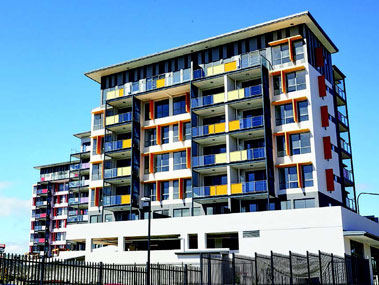Strategic investments and the use of innovative construction materials and models will be crucial as governments and construction companies play their part in addressing Australia’s affordable housing crisis.
By Cameron Cooper
At last count, Australia had a shortage of 173,000 affordable dwellings, according to research by the Australian Housing and Urban Research Institute (AHURI).
The predicament is creating inequitable living conditions across the nation and represents an opportunity for property developers, construction companies and investors to step in with inventive housing solutions. Charles Northcote, CEO of community housing provider BlueCHP, understands the issue better than most, with the group having delivered more than 1900 social, affordable and disability homes since 2008.
The group’s portfolio includes The Gardens project in Campbelltown, Sydney, which featured the use of cross laminated timber (CLT), a cost-effective engineered wood panel product.
Northcote says the failure of Australia to address the affordable housing situation for the less well-off must be addressed. “A lot of people throw up their hands and say it can’t be done, but I don’t believe that.”
Investing in the future
For more affordable housing to become a reality in Australia, investment in construction projects that benefit low income and disadvantaged Australians will be crucial.
Kris Daff is the managing director of two enterprises—Assemble, a build-to-rent developer, and Make Ventures, a property development and investment company—that are committed to affordable housing projects.
Late last year, Assemble secured rezoning approval for two residential and mixed-use sites in Clayton and East Bentleigh in Victoria, respectively valued at a total of $1.2 billion. This will allow the group to deliver in excess of 1600 social and affordable housing units.
The developments will provide either long-term cheaper leases for low-income residents, or long-term leases with the option to buy the property after an agreed period of time. Daff says the ability to partner with large investors such as superannuation funds to construct hundreds or thousands of dwellings at a time is crucial. “To have meaningful impact you have to execute at scale,” he says.
Innovation to the fore
The Gardens project in western Sydney is the largest residential timber building in Australia and comprises 101 apartments, 56 of which are available for affordable rental through BlueCHP. The use of about 962 tonnes of sustainably sourced CLT reduced the need for steel and concrete and cut down significantly on building costs, while also resulting in lower levels of carbon emissions and waste during construction.
In addition to CLT, Northcote believes lightweight steel structures have an important role to play in social and affordable housing projects, as well as using systems such as BIAX, an ecofriendly foundation that uses recyclable materials instead of regular waffle-pod concrete slab systems.
While such singular measures are important, he says the key is to develop an entire supply chain that drives efficiencies and value.
“Lots of little things make the difference—it’s not one whiz-bang element that does it.”
Modular and other prefabricated housing options are also increasingly on the agenda for affordable housing developers. The ability to partly construct units in factories and ship them to construction sites for final assembly can also slash building times.
Daff notes that in the United Kingdom it is now possible to see affordable housing developers lifting in multistorey prefabricated dwellings that have furniture and even microwaves and kettles in place.
“We joke that you could almost lift the homes in with the tenants in them,” he says. With modular projects, the main advantage is speed of installation. “But we think over time as these manufacturing businesses integrate more robotics and other technologies into their production lines, we will see both time and material cost advantages compared with traditional on-site building,” Daff says.
For Assemble’s project pipeline, it is partnering with modular bathroom manufacturer Interpod. “So we might do 5000 apartments and just have three types of bathrooms across that portfolio. This allows your supply chain to respond and drive efficiencies and become more formulaic,” Daff says.
This compares with traditional off-the-plan developments that need a “shiny, bespoke” bathroom as a point of difference at sale. “Whereas when you’re building housing that’s rented out for the long term, what you want is good quality, efficient dwellings that are not too expensive to maintain,” Daff says.
No greater technical challenges
A test with affordable housing is getting all facets of construction right, from the sourcing of materials and equipment to the logistics of getting the job done. However, Northcote does not believe such projects present any greater technical difficulties than traditional housing construction jobs. Indeed, he wants to reassure builders that they can easily participate in the community housing space.
“You have to get the design right first and understand what you want to achieve. But don’t change things too much from existing building practices that are working. Use them, tweak them and you’ll get an efficient outcome,” he says. “Trying to make wholesale changes is very difficult.”
For BlueCHP, the design and operational costs of the homes are front and centre, along with getting simple building elements right such as waterproofing and ventilation. As an example of practical innovation, BlueCHP has pioneered a drawer and wardrobe storage combination that removes the need to buy separate products. This, in turn, speeds up installation and cuts down on costs.
“Now you see builders incorporating that as a standard product on projects,” Northcote says. “These little design elements often get missed.”
BluCHP is also trialling new solar initiatives at one project in Sydney, while Northcote believes more double-glazing in affordable housing developments can improve thermal efficiency.
Rent-to-build in vogue
A report by the Productivity Commission of Australia has indicated that, in 2021, 45.7 per cent of Australians receiving Commonwealth Rent Assistance were spending more than 30 per cent of their income on rent, a calculation that defines people experiencing housing stress.
Build-to-rent developments are a relatively new urban housing concept in the Australian market that could deliver more affordable housing options. With such projects, the developer retains ownership of the building when it is complete and the dwellings are rented out to tenants, as opposed to the normal build-to-own model.
Daff believes the built-to-rent model is set for significant uptake in the Australian market. That will present opportunities for developers, materials suppliers and builders to participate, although cautious financiers and investors will in the short term probably stick mostly to traditional construction methods.
Nevertheless, Daff expects innovative modular design to ultimately dominate the affordable housing space in Australia, while the rising use of CLT, including from Australian suppliers, will become more and more prevalent as investors seek to minimise building costs and carbon emissions.
“There’ll be nuances to the design and servicing of buildings, and even little things around the way joinery in installed, for example, so you change benchtops more easily 10 years later. But what we’ll see over time is a lot more modular developments.”
With an eye to the future, BlueCHP is confident that affordable housing projects will improve lives for people on lower wages and let them live closer to their places of employment in CBDs.






